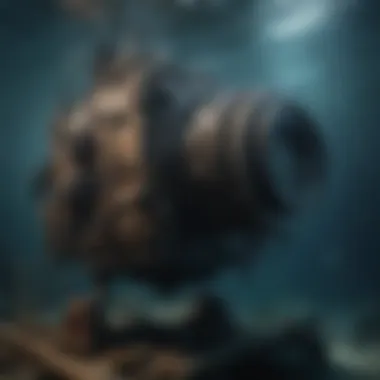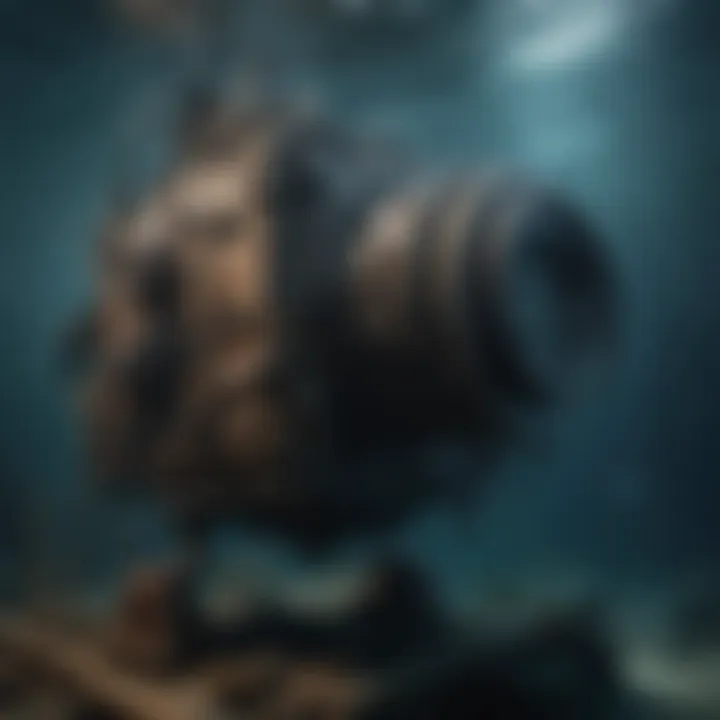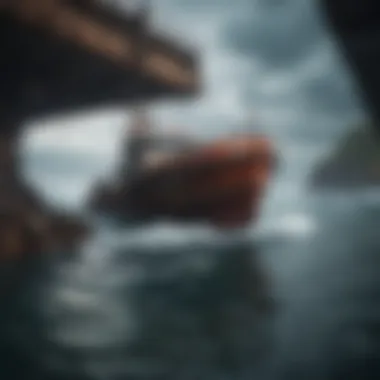Underwater Salvage: Techniques and Future Challenges


Intro
Underwater salvage is a fascinating field that combines technology, risk, and environmental stewardship. Professionals in this sector are dedicated to retrieving lost or sunken objects, which can range from historical artifacts to valuable commercial goods. This article will explore the various techniques used in underwater salvage, the unique challenges professionals face, and the potential future developments in this important area.
Historical Context
Understanding the historical aspects of underwater salvage helps one appreciate the complexity of the task. From ancient times, people have sought to recover objects from beneath the sea. Historical texts inform us about shipwrecks and the valuable cargo they often contained. This activity has evolved significantly, especially with advancements in technology.
Technological Advancements
Modern underwater salvage operations employ sophisticated equipment. Technologies such as remotely operated vehicles, sonar mapping, and advanced diving gear have transformed the landscape. Additionally, computing power allows salvage teams to analyze data and plan operations with remarkable precision.
**"The tools of underwater salvage have undergone a revolution, allowing professionals to operate in deeper and more treacherous waters."
Ecological Implications
It is essential to consider the ecological impact of salvage operations. While retrieving sunken artifacts can be significant for historical preservation, it may disrupt marine ecosystems. Salvage professionals must ensure that they follow guidelines to minimize harm to aquatic life.
Challenges Faced by Salvage Professionals
Salvage operations are not without challenges. Legal issues can arise regarding ownership of salvaged items. The unpredictable nature of marine environments further complicates retrieval efforts, necessitating adept problem-solving skills.
The Importance of Underwater Salvage
The field of underwater salvage holds significance across various domains, including archaeology and commerce. Recovering artifacts contributes to historical knowledge, while salvaging commercial goods can aid in financial recovery for companies. Additionally, the field offers insights into environmental management, highlighting the need for responsible practices in marine settings.
As we delve deeper into the techniques, challenges, and future directions of underwater salvage, it becomes clear that this field is both complex and crucial.
Prelims to Underwater Salvage
Underwater salvage refers to the complex process of recovering objects that have been lost or sunk in water bodies. This field is not only significant for its commercial aspects but also for its contributions to archaeology and environmental management. Understanding underwater salvage is crucial as it helps in preserving history, contributing to the economy, and addressing ecological concerns.
Definition and Scope
Underwater salvage encompasses a variety of techniques and methodologies used to locate and recover valuable items submerged in lakes, rivers, and oceans. The scope of underwater salvage spans from retrieving sunken ships to recovering lost cargo, historical artifacts, and even natural resources.
The key components include:
- Diving Operations: This involves professional divers who perform search and recovery missions underwater.
- Technological Advances: Innovations like Remote Operated Vehicles (ROVs) and sonar mapping have expanded the range and efficiency of salvage operations.
- Legal and Ethical Considerations: Salvage operations must align with local laws and regulations to ensure the protection of cultural heritage.
By exploring these aspects, it becomes evident that underwater salvage is not just a means of retrieving lost items; it is a multidisciplinary field that intersects technology, law, and archaeology.
Historical Overview
The history of underwater salvage stretches back thousands of years. Ancient civilizations sought to retrieve valuable cargo from shipwrecks. The techniques were rudimentary at first, relying solely on human capability and limited equipment. Over time, as technology evolved, so did salvage methods.
In the 19th century, the advent of steam-powered pumps and specialized diving suits revolutionized salvage operations. The infamous RMS Titanic disaster in 1912 brought renewed interest in underwater recovery.
More recent advancements, notably in the 20th and 21st centuries, have included the use of sophisticated sonar technologies and robotic vehicles. These developments have significantly enhanced the ability to locate and recover submerged objects, opening new possibilities in both commercial and archaeological salvage.
Techniques of Underwater Salvage
The techniques employed in underwater salvage are crucial for the successful recovery of sunken treasures and crucial objects from the depths of water bodies. Each method has its unique advantages and challenges, catering to different recovery situations and environmental conditions. A solid understanding of these techniques not only informs salvage operations but also lays the groundwork for future advancements in this field.
Diving Operations


Diving operations have been a cornerstone of underwater salvage for decades. Professional divers are trained to work under various conditions, including strong currents and murky waters. They are equipped with specialized gear such as diving suits and tanks that provide oxygen. The ability to physically interact with submerged objects is a significant advantage of this method.
However, diving comes with risks. The physical pressure increases as divers descend, presenting dangers like decompression sickness. This hazard necessitates meticulous planning and risk assessment before each operation. Also, divers might face challenges in low visibility, which can complicate recovery efforts.
Remote Operated Vehicles (ROVs)
Remote Operated Vehicles, or ROVs, represent a significant technological advancement in underwater salvage. These unmanned vehicles are equipped with cameras and various tools, allowing them to work in conditions unsafe for human divers. ROVs can operate at great depths, retrieving objects while sending real-time video back to the surface.
Their remote nature reduces risk to human life. However, they are not without limitations. ROVs require skilled operators and can be expensive to deploy. Additionally, they may struggle with fine manipulation of delicate items, which often necessitates visual and tactile feedback that only a diver can provide.
Sonar Technology
Sonar technology has transformed the way salvage operations locate submerged objects. The technology utilizes sound waves to create images of the underwater environment. Different sonar systems, such as side-scan sonar, can detect objects at considerable depths, forming a detailed map of the seabed.
This technique is essential for initial assessments of salvage sites. It helps divers and operators identify the type of materials on the ocean floor and plan subsequent recovery activities. While sonar provides a comprehensive view, factors like water temperature and salinity can influence its effectiveness, making it an area of ongoing improvement and research in underwater salvage.
Hydraulic Tools
Hydraulic tools have become instrumental in underwater salvage operations, particularly for lifting and removing heavy objects. Tools such as hydraulic shears and lifting bags use water pressure to generate immense force, enabling salvage teams to manage even the most challenging recoveries.
The precision these tools offer is critical in delicate situations, such as artifact recovery in archaeological contexts. However, the complexity of these tools demands thorough knowledge and experience among operators. Proper training ensures they can efficiently and safely apply these tools without causing unintended damage to fragile artifacts or marine ecosystems.
Challenges in Underwater Salvage
The realm of underwater salvage encompasses a myriad of challenges that complicate the retrieval of lost or sunken objects. These challenges are critical to understanding not just the complexities involved in salvage operations, but also their implications for the environment, law, and safety. Awareness of these issues is essential for professionals in the field, as each challenge presents unique hurdles requiring specific approaches for mitigation. Addressing these challenges can lead to more effective salvage operations and ultimately ensure the preservation of underwater cultural heritage and ecological balance.
Environmental Obstacles
Underwater salvage operations often grapple with significant environmental obstacles. The marine environment is both unpredictable and diverse, which can substantially affect salvage plans. Factors such as strong currents, wave action, and varying water temperatures can impact the executeion of operations and the safety of divers and equipment. Additionally, the presence of marine life, including large mammals and coral reefs, adds another layer of complexity. Salvage experts need to conduct thorough environmental assessments prior to any operation. Understanding the habitat and conditions not only helps in planning the salvage process but also aids in mitigating potential damage to ecosystems.
Legal Frameworks and Regulations
Operating within the legal frameworks surrounding underwater salvage is crucial for the success of any recovery project. International laws, such as the United Nations Convention on the Law of the Sea, establish guidelines on maritime jurisdiction and ownership of sunken vessels. National and local regulations further complicate the landscape, often governing how, and if, recovery can take place. Compliance with these laws is paramount to avoid legal disputes or penalties. Salvage professionals require a solid understanding of these legal frameworks to navigate permissions and ensure their operations are lawful.
Compliance with legal frameworks is not just a matter of avoiding penalties; it can also protect cultural heritage and promote responsible salvage practices.
Safety Risks
The underwater environment poses inherent safety risks. Divers face challenges such as decompression sickness, equipment malfunctions, and visibility issues. Training in advanced diving techniques and the use of state-of-the-art equipment is essential to minimize these risks. Furthermore, all salvage operations must have contingency plans in place. These include emergency protocols for medical attention, equipment recovery, and evacuation plans. Ensuring safety not only protects the lives of those involved but also contributes to the successful completion of each salvage operation.
The Role of Underwater Salvage in Archaeology
Underwater salvage plays a vital role in the field of archaeology, revealing insights into past civilizations that are otherwise lost to time. This discipline provides unique opportunities to recover artifacts and structures submerged under water, offering a window into historical narratives that are often overlooked. The benefits of engaging in underwater salvage are multifaceted, spanning cultural, educational, and scientific realms.
Recovering Historical Artifacts
Recovering historical artifacts is one of the primary objectives of underwater salvage. These artifacts can include shipwrecks, cargo, tools, and even human remains, each telling a story about maritime trade, warfare, or daily life. Artifacts recovered from underwater sites can significantly enrich our understanding of history. They allow archaeologists to piece together how societies operated and interacted.
The preservation of such artifacts is often superior in underwater environments. Factors like temperature, salinity, and lack of sunlight can create a more stable condition compared to land-based sites, where erosion and vandalism are more prevalent.
Moreover, the techniques employed in recovering these artifacts, whether through diving or the use of Remote Operated Vehicles (ROVs), have continued to evolve. Contemporary methods also include rigorous documentation processes, ensuring that each find is properly cataloged and analyzed. The historical context of artifacts is thus preserved alongside their physical forms, offering invaluable data for future research.
Documenting Underwater Sites
Documenting underwater sites is equally essential to the archaeological process. This involves creating detailed records of the site’s layout, the spatial relationships between artifacts, and the surrounding environment. Technologies such as sonar mapping and 3D modeling have advanced the way archaeologists document submerged landscapes, allowing for an in-depth analysis of how artifacts relate to one another.


Through comprehensive documentation, researchers can also assess the impacts of environmental changes over time. This is increasingly relevant as climate change becomes a pressing global concern. By analyzing how underwater sites have been altered by natural phenomena, archaeologists can gain insights not only into human history but also into future challenges that such sites may face.
"The careful documentation of underwater sites ensures that we do not lose our connection to history, even as the world changes around us."
Commercial Aspects of Underwater Salvage
The commercial aspects of underwater salvage are crucial for understanding the practical implications of this field. Underwater salvage is not just a matter of recovering lost items; it involves a complex interplay of financial investments, market opportunities, and the risks associated with operating in challenging environments. Salvage operations often require significant capital for equipment, technology, and skilled personnel. This has led to the establishment of specialized companies that focus on recovering valuable items from the ocean floor.
Successful commercial salvage operations can yield substantial profits. Items recovered can include shipwrecked cargo, precious metals, or archaeological artifacts. However, the financial success of such operations does not come without challenges. Investors must navigate legal restrictions, environmental considerations, and safety concerns, which may affect the feasibility of a project. Understanding the commercial landscape is vital for anyone looking to engage in or invest in underwater salvage.
Commercial Salvage Operations
Commercial salvage operations are driven by both demand and opportunity. Organizations capable of executing these operations usually possess advanced technology, experienced divers, and a solid business plan. Key aspects of these operations include:
- Contractual Agreements: Salvagers often work under contracts that outline profit sharing and ownership rights of recovered objects.
- Resource Allocation: Efficient use of resources, including time and personnel, is essential for successful salvage.
- Market Demand: The potential profitability of an operation is largely dependent on the market demand for recovered items, especially precious metals or historical artifacts.
These operations use a variety of techniques, including ROVs and sonar technology, to locate and retrieve objects. The successful completion of commercial salvage can lead to lucrative returns, but the work is often fraught with uncertainties.
Insurance and Financial Considerations
Financial considerations are pivotal in underwater salvage, especially regarding insurance. Salvage operations typically involve high risks, making it vital to secure the right insurance policies. Often, operators must evaluate several types of coverage, such as:
- Marine Insurance: This covers the vessel and equipment used during salvage.
- Liability Insurance: Important for protecting against claims from third parties affected by salvage activities.
- Workers’ Compensation Insurance: Essential to cover injuries that may occur on the job.
Understanding the financial implications of an operation is just as crucial as the physical recovery process itself. Investors need to perform a thorough risk analysis before embarking on a salvage endeavor. The financial stakes can be high, and the consequences of failure can be significant.
"Underwater salvage is as much a financial endeavor as it is a technical one. Evaluating risks and securing proper insurance are fundamental to success."
In summary, the commercial aspects of underwater salvage are intertwined with the operational processes and the economic reality of the market. As this field continues to evolve, understanding these elements will be paramount for anyone looking to enter the industry.
Future Directions in Underwater Salvage
Underwater salvage is at a crucial juncture, influenced by advancements in various fields that reshape its techniques. The focus on future directions is essential for understanding how this discipline can evolve while addressing modern challenges. As technology progresses, salvage operations have the potential for increased efficiency and effectiveness. This section explores innovations in technology and the implementation of sustainable practices, both of which are pivotal to the future of underwater salvage.
Innovations in Technology
Technological innovations play a significant role in the advancement of underwater salvage operations. One of the most prominent developments is the enhancement of Remote Operated Vehicles (ROVs). These unmanned systems have become more sophisticated, equipped with better cameras and manipulation arms. They can operate at deeper depths and in more challenging environmental conditions. This allows for the recovery of artifacts and materials that were previously inaccessible.
Additionally, sonar technology has seen remarkable progress. Modern sonar systems can create detailed maps of the ocean floor. This makes locating shipwrecks and other valuable items much easier. The integration of Artificial Intelligence (AI) for data analysis can provide insights into the patterns and locations of underwater objects, which can optimize salvage missions.
Another remarkable innovation is in diving technologies. Advanced diving suits and systems allow divers to work under extreme conditions. This increases the safety and capability of human divers in complex salvage missions. Enhanced breathing systems and communication devices mean divers can now work collaboratively with surface crews more effectively.
Sustainable Practices
Sustainability is increasingly important in underwater salvage. As environmental concerns rise, adapting salvage practices to minimize ecological impact is critical. One strategy is to prioritize the recovery of materials that may pose a threat to marine life, such as oil spills or hazardous debris. This aligns with environmental protection goals and can contribute positively to marine ecosystems.
To mitigate the environmental impact, salvage operations are encouraged to adopt methods that reduce disturbance to underwater habitats. For instance, employing specialized equipment that minimizes sediment disruption can protect delicate ecosystems.
Moreover, the concept of preserving underwater cultural heritage is gaining traction. Salvage operations should not only focus on economic gain but also consider their role in protecting historical artifacts. Collaborative efforts with archaeologists can ensure that significant finds are recorded and preserved for future generations, respecting their cultural value.
"Innovations in the field and sustainable practices will define the next era of underwater salvage, merging technological advancement with environmental stewardship."
The Environmental Impact of Underwater Salvage
The environmental impact of underwater salvage is critical for understanding the implications of retrieving objects from marine environments. Salvage operations can disturb delicate ecosystems, affect marine life, and alter habitats. Therefore, it is essential to assess these impacts carefully. Understanding how salvage activities affect the environment aids in developing practices that minimize harm. Furthermore, awareness of the ecological considerations ensures the sustainability of marine resources for future generations.


Ecological Considerations
Salvage operations can lead to various ecological consequences. The disruption of the seabed during excavation can release sediments, which can cloud the water and harm aquatic organisms. For instance, the physical removal of a shipwreck can alter natural reef structures, affecting species that depend on those habitats. Additionally, the noise generated by salvage equipment may interfere with marine life communication, particularly among species that rely on sound for navigation and mating.
Key ecological considerations include:
- Effects on Local Biodiversity: Recovery efforts may unintentionally damage habitats, leading to a decline in species diversity. Species that rely on specific environments may face extinction risks if these habitats are destroyed.
- Endangered Species: Salvage operations conducted in areas where endangered species reside need careful permitting and monitoring to avoid jeopardizing their populations.
- Water Quality: Activities that disturb sediments can release trapped pollutants, posing risks to water quality and marine life.
Mitigation Strategies
To reduce the negative environmental impact of underwater salvage, several mitigation strategies should be employed. Awareness and proactive measures can ensure that salvage operations are carried out with respect for marine ecosystems. Effective management can contribute to preserving marine biodiversity while still achieving salvage goals.
Some recommended mitigation strategies include:
- Environmental Impact Assessments (EIAs): Conducting thorough EIAs before salvage operations can help identify potential risks and inform the development of strategies to minimize destruction.
- Use of Technology: Employing technologies such as Remote Operated Vehicles (ROVs) allows for precision during salvage operations, reducing the extent of habitat disturbance.
- Collaboration with Environmental Agencies: Working alongside marine conservation organizations ensures compliance with legal frameworks and fosters best practices.
- Training for Salvage Teams: Ensuring that teams are educated on the ecological impacts of their work can promote awareness and decrease the likelihood of environmental damage.
"To balance salvage efforts and ecological preservation requires an ongoing commitment to informed practices."
By understanding the ecological considerations and adopting sound mitigation strategies, underwater salvage can strive to protect marine environments while achieving its objectives.
Case Studies in Underwater Salvage
Case studies in underwater salvage highlight the practical applications and real-world implications of this intricate field. Each recovered artifact tells a story, reflecting historical contexts, cultural significance, and technological advancements. Analyzing these case studies can provide awareness of the methodologies employed during salvage operations and demonstrate the challenges faced. Such insights are vital, not only for professionals engaged in this field but also for the broader audience interested in history and preservation efforts. Understanding past recoveries can inform future practices, ensuring that underwater salvage is conducted with respect for the environment and cultural heritage.
Famous Shipwreck Recoveries
Famous shipwreck recoveries stand as pivotal examples within underwater salvage. One of the most notable instances is the recovery of the RMS Titanic. Discovered in 1985, this shipwreck lies nearly 12,500 feet below the North Atlantic surface. The complexity of salvaging artifacts from Titanic required innovative technology and careful planning, addressing both preservation concerns and ethical questions surrounding the site's value as a grave.
Artifacts recovered from the Titanic, such as personal belongings and structural components, were meticulously catalogued. The exhibition of these items allowed the public to connect with history, sparking an enduring interest in maritime archaeology. The Titanic's recovery also served as a catalyst for discussions about the legal and ethical dimensions of underwater salvage.
Another significant recovery is that of the Spanish galleon Nuestra Señora de Atocha. This ship sank off the Florida Keys in 1622, carrying substantial treasure. In the 1980s, treasure hunter Mel Fisher and his team located the Atocha, leading to a historic salvage operation that unearthed more than $450 million in gold, silver, and jewels. This case illustrates the merging of commercial ambition with archaeological integrity, raising questions about ownership, preservation, and the responsibility of salvagers.
Modern Salvage Operations
Modern salvage operations incorporate advanced technology and refined techniques that enhance efficiency and safety. The use of remotely operated vehicles (ROVs) has become increasingly common. ROVs allow teams to explore depths that divers cannot reach and provide high-definition visual data of the underwater environment. This capability aids in identifying recovery sites without compromising safety.
One noteworthy operation is the 2012 salvage of the Costa Concordia, a cruise ship that capsized off the coast of Italy in 2012. The salvage operation was one of the largest ever attempted, requiring careful planning to avoid environmental hazards. Crews employed a sophisticated system of underwater cables and hydraulic systems to right the vessel and safely remove it from the seabed. This operation emphasized environmental considerations, showcasing how modern salvage can proceed with a more conscious approach to ecological impact.
Another example of modern operations is the recovery of the USS Oklahoma, a sunken battleship from World War II. In 2020, efforts to locate and identify remains were underway. This operation highlighted the intersection between naval history and the importance of honoring those who lost their lives. By utilizing advanced sonar technology combined with ROVs, teams were able to map the wreck meticulously, ensuring that the recovery adhered to both ethical and legal standards.
The assessment of these modern salvage operations emphasizes the ongoing evolution of underwater salvage methodologies and revitalizes interest in the historical contexts. They serve as case studies not just of recovery, but also of the importance of adhering to ethical standards—balancing the urge for discovery with preservation and respect for the past.
Ending
The conclusion of this article serves to underline the multifaceted aspects of underwater salvage. It is essential to summarize the entire discourse that transpired throughout the sections, reiterating the significance of various techniques and challenges. This is not merely an academic exercise but an important consideration for the future directions of the field.
Summary of Key Points
Underwater salvage encompasses a range of techniques that include diving operations and advanced technology like Remote Operated Vehicles (ROVs) and sonar. Each method has its challenges. Environmental conditions can be harsh and are often not conducive to salvage work. Furthermore, the legal frameworks governing salvage work complicate operations. Safety remains paramount and needs attention in every project.
The significance of underwater salvage extends beyond recovering artifacts; it plays a vital role in archaeology, contributing to our understanding of past human activities. Commercial aspects must also be considered, as salvage can have significant financial implications. Moreover, the ecological footprint of salvage operations cannot be ignored. Sustainable practices in the future are critical to lessen these impacts while innovating technologically.
Implications for Future Research
The ongoing evolution of underwater salvage necessitates further research into several key areas. Innovations in technology will continue to shape methods and efficiency in salvage operations. Emerging tools and developing sustainable practices are areas ripe for inquiry.
Exploring the legal implications and ethical considerations surrounding underwater salvage is another vital field of research. As technology advances, it may also present new challenges regarding ownership and rights of recovery. Researchers may also want to investigate the long term environmental impacts of underwater salvage practices, focusing on mitigation and restoration strategies.
Overall, the understanding of underwater salvage will benefit from interdisciplinary approaches, linking technology, environmental science, and archaeology. Academic literature and practical applications must collaborate to develop a more comprehensive framework for salvage operations moving forward.
"Underwater salvage is not just about recovery; it's about understanding our past and protecting our oceans for the future.”
This combination of techniques, ethical considerations, and sustainable practices will ensure that underwater salvage not only thrives but also contributes positively to society and the environment.







